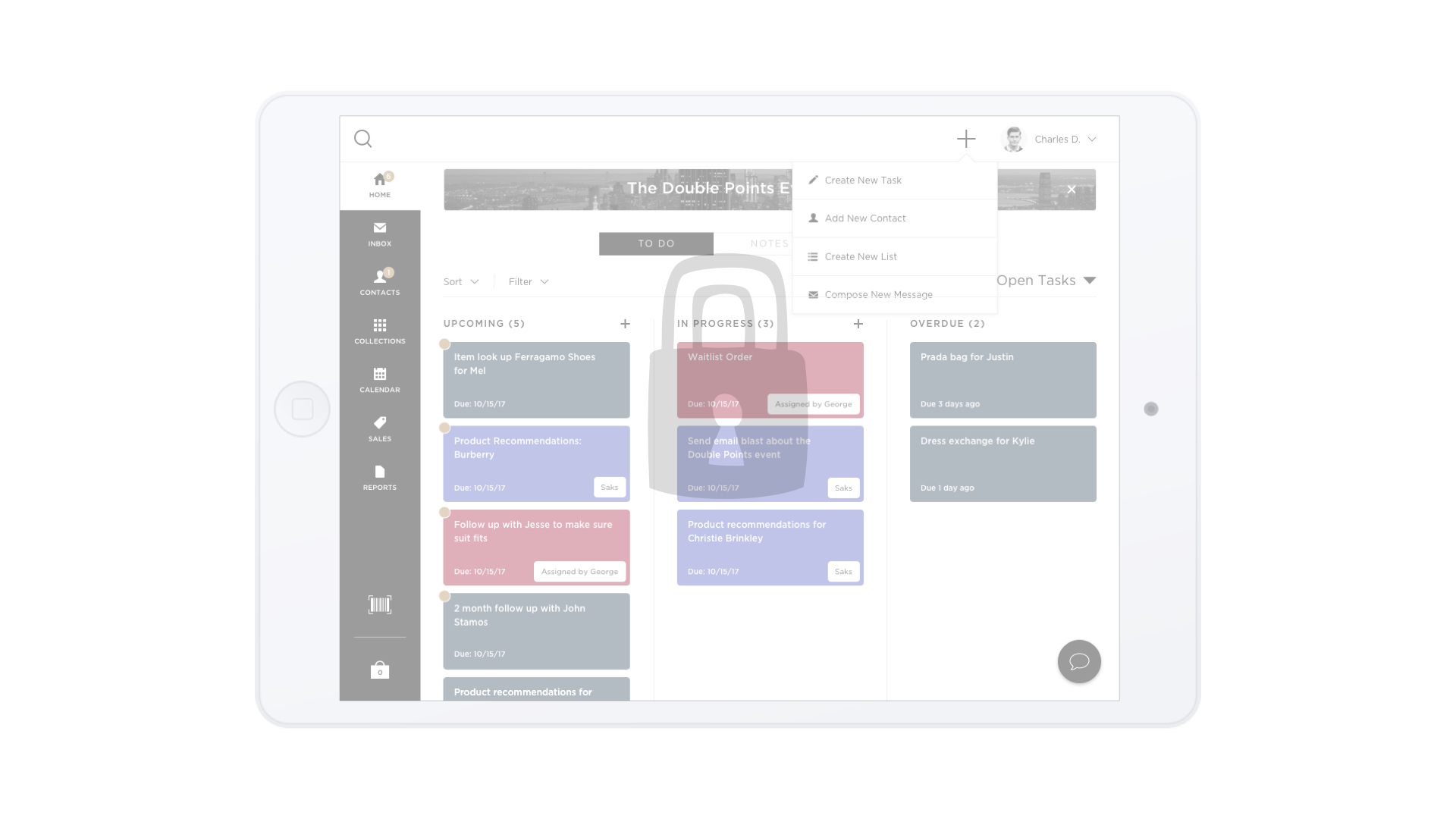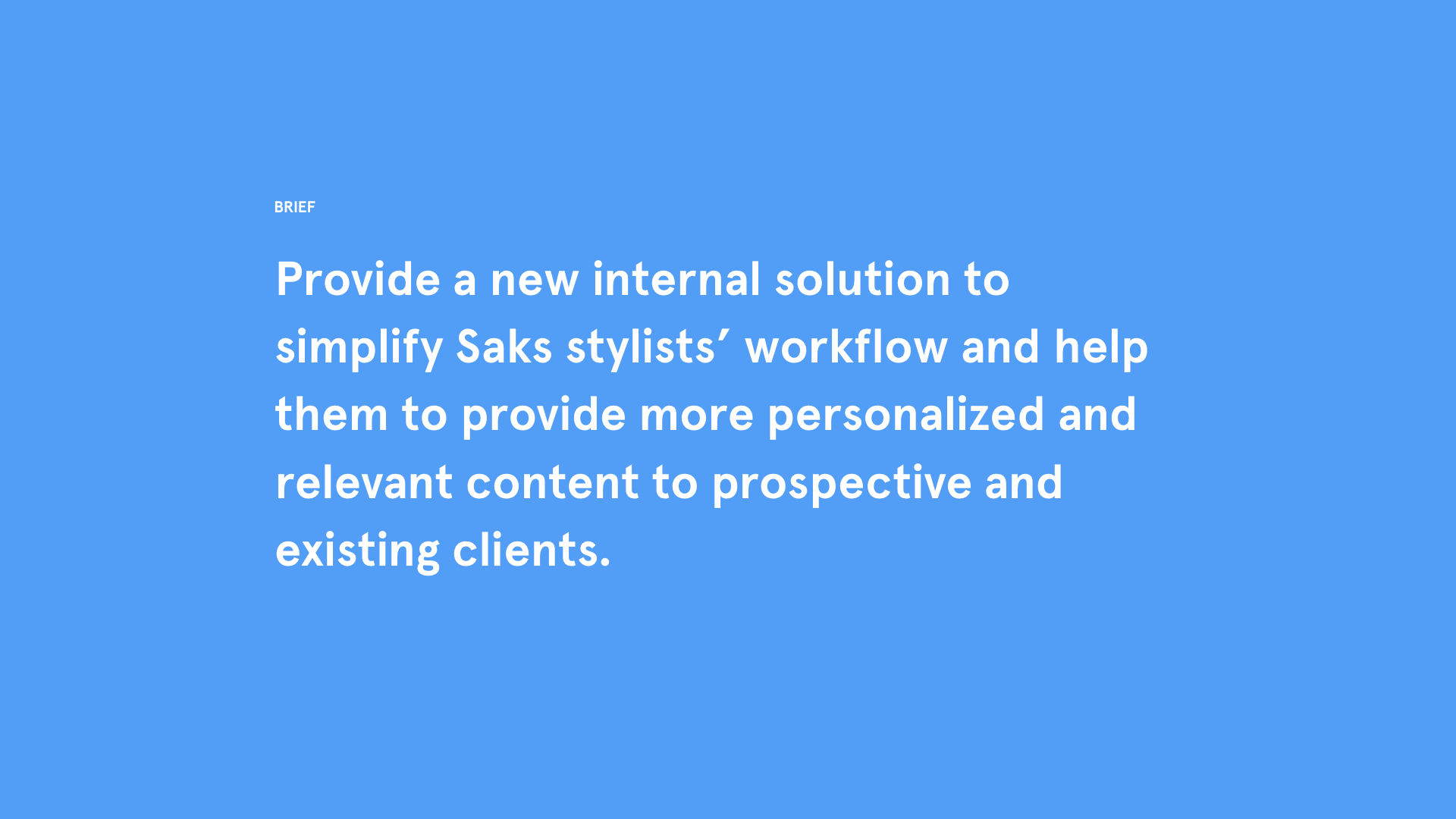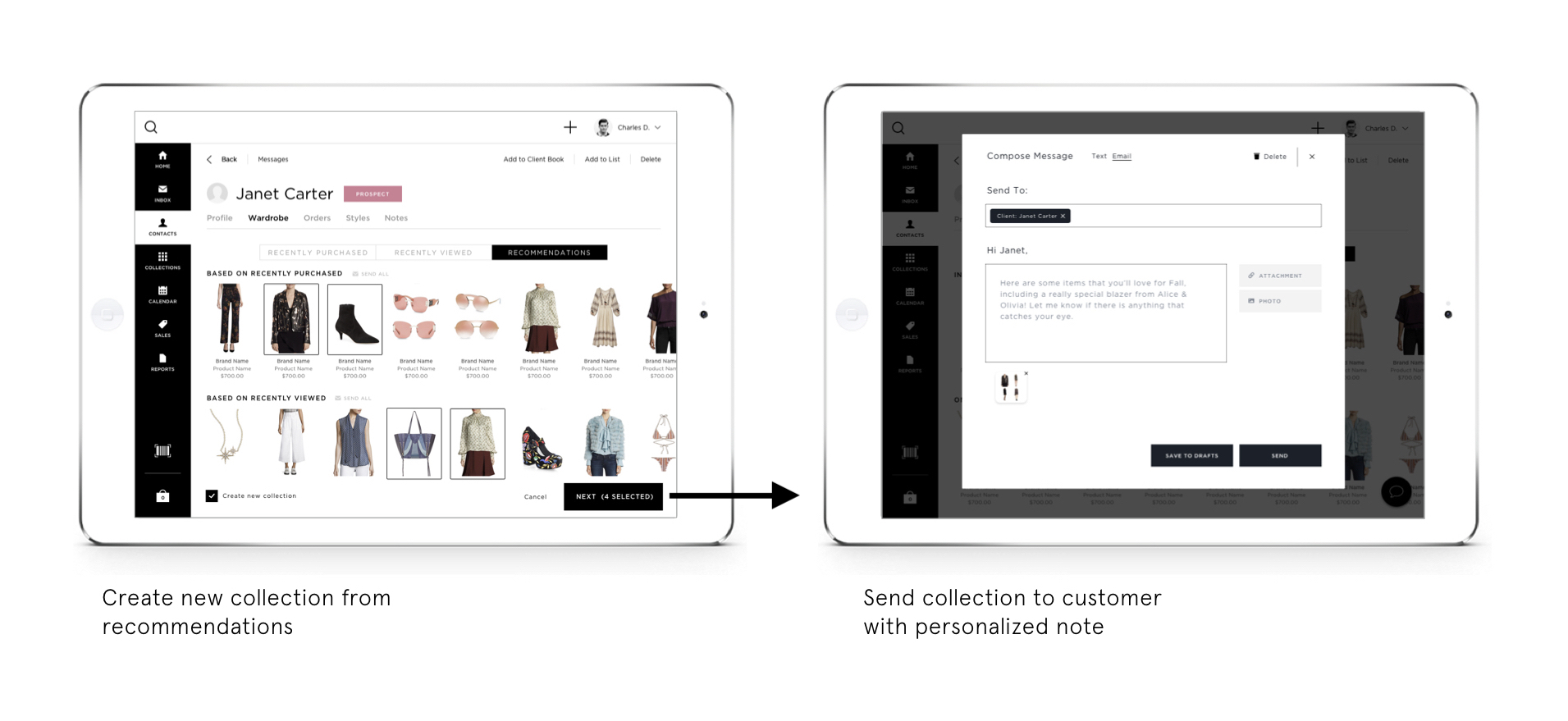
Unified Stylist App
For this project my responsibilities included product strategy, user research, UX design and prototyping. I worked alongside a Product Manager and Lead Engineer from Gilt and partnered with a visual designer to design and iterate on the prototype.
Product Design Lead, 2017

Background
After a year of insight into the Saks Fifth Avenue stylists’ workflow while working on the iMessage app and Mobile Stylist, I conceptualized a new unified platform with the two main goals of reducing the more tedious and time-consuming aspects of stylist’s workflows and helping them to focus on building great relationships with customers.
In previous projects I learned that one of stylists’ top pain points was the number of places they need to go to connect with, communicate with and sell to customers - not to mention the usability shortcomings of the legacy software used by Saks stores.
Another major pain point was in the area of receiving blind leads through their existing online lead generating tool. When receiving a new request online, stylists had no way to educate themselves on who the customer is in order to provide the best recommendations. This led to generic and impersonal communications, templated mass emails, and a diminished image of the Saks styling service.
Saks has a rich history of over 100 years of “high-touch” service - our team aimed to help stylists convey this expertise through informed, useful and relevant communications with customers.

Discovery
The diagram above shows the capabilities and overlap of the stylist toolset, in the current and future state. This illustrates the digital and analog tools that Associates are currently using, as well as what we were building internally. We realized that it would be essential to simplify the stylist workflow with the product we were building, rather than complicating it further.
Since this project aimed to connect the physical and digital experience of Saks stylists, we had the additional complexity of merging two separate inventory databases. The online inventory database was completely separate from the in-store database, and they didn’t have any way of talking to each other. In the first phase of the project, we worked closely with the data team to understand the possibilities around streamlining inventory lookup and helping stylists to make queries to one simplified source.

Workflow audit
Also in the research and discovery phase I created an audit of every task and responsibility of the stylist along the selling timeline. These responsibilities include what the stylist needs to know from the customer, how they need to communicate with the customer, and how they currently accomplish these tasks with existing tools.
Saks stylists have two ways of connecting with customers. One way is through the physical space of the store, when a customer walks in and asks for help finding something. The other way is through the entry point on the Saks website and in the apps where customers can ask to connect with a stylist for questions about products, styling for an upcoming event or more general wardrobe needs.
On a typical day, outside of their responsibilities in-store, stylists will check their online selling tools from either their personal mobile phone or shared tablet device in-store, see if they received any new leads or messages from existing clients and respond to those, and look at their reminders for reconnecting and following up on existing contacts and prospects. To do research on prospective customers, they often check their social media accounts to learn about their lifestyle and current wardrobe choices.
Top Saks stylists could have up to a $2M/year client book, while other stylists are just starting out building their client book. One of the safeguards that Saks has in place to protect their top sellers is to lock the customer profiles that already have well established relationships with stylists, so that only their stylist can see their history and activity.

Early sketches and prototypes
The first component of the stylist app that began to take shape was a customer insights dashboard. It was clear from the research that stylists struggled to learn enough about customers to provide meaningful recommendations. The goal with this first phase of the project is to provide an accessible and insightful snapshot of the customer’s style preferences and purchase history.
I started with a paper prototype, sketching out the different data visualizations then moving the layers around, cutting and taping to form the layout and organization that made sense to me based on my knowledge of the stylist needs and workflow.
To kick off the research phase I then created a high-fidelity clickable prototype of the insights dashboard and scheduled 6 pair interviews at the Saks Fifth Avenue Long Island location. This research was valuable in determining product and design decisions, especially relating to customer queries, inventory search, notes and actionable tasks.
Also using these early prototypes I worked closely with the product manager and backend engineer to confirm the types of data that we’d be able to work with, proposing a mix of implicit and explicit data. In the app we’d be presenting data that’s collected from customers’ previous purchases and online activity, in addition to data that they’ve provided in the way of following brands or the new style quiz.

Accept leads and view customer insights
This component of the unified stylist app aimed to solve the two biggest pain points from my early research - blind leads and the fragmentation of tools. In this new platform, stylists would be able to accept new leads, and begin to learn about who they are right away in order to follow up with relevant and useful information.
Stylists are on their phones at home when starting and finishing the day, and on shared tablets in the stores, so this platform would be optimized for tablet and available in abbreviated form for use on their personal device.

Relevant product recommendations
In the store, the stylist may not have a chance to learn about the customer before providing service, so this tool would provide the most value for the follow up or ”clienteling” phase (whether the customer made a purchase or not). It would help stylists learn which products to recommend based on customers’ purchase history and online activity. The intention is to make those communications more relevant and valuable to customers than they had been previously.
Saks customers trend wealthy, upscale, and professional. They’re women and men who want to look their best, either for an upcoming board meeting or charity gala, etc. One of the goals of the overall stylist initiative was to elevate the Saks styling service to convey their expertise and to enhance the value they can provide.
The Gilt tech team has well-developed machine learning capabilities, and have made great progress into visual search and similar product recommendations for Gilt. I worked with this team to establish the possibilities for using this technology within an internal tool aimed at helping Saks associates recommend more relevant products for their prospects and clients.
The insights help stylists understand their buying and browsing habits, so they can find even better ways to enjoy their shopping experience. In many cases as well, this data being shared was often initiated by the stylist as well. With regard to privacy, this service is something that customers opt-into automatically by either connecting with an Associate online or making their first purchase.

Research insights
After working on the Mobile Stylist and iMessage projects, I had already spoken to around 15 Saks stylists. I brought that knowledge into this round of 6 pair interviews at the Saks Long Island location, which gave us great insight in order to take the project in a more informed direction.
One of the themes that surfacing was that stylists needed the ability to take notes on the fly for customer follow up. For example, a customer that just purchased a $3000 gown, a customer they just shared a collection with, etc. They want to have an area where they can jot this down or even create an actionable To Do item from it.
Another theme that was super interesting was the need for associates to create customer groupings based on their purchase history and affinities. For example, stylists want to reach out to all of their Burberry customers with new arrivals, or all customers who buy over $600 shoes when there’s a new in-store event.
Also in our associate interviews they made it very clear that brands are a key indicator of the customer style and budget. Other most useful data points are the ability to drill into details about customers’ past orders is useful, as well as seeing order frequency and spend per category.

Task management and automation
As backend development started on the insights dashboard, I gathered the learnings from the stylists we spoke to and began sketching out new workflows incorporating solutions that would solve some of their needs.
One of the features I was most excited about were actionable tasks, shown in the first user flow above. I used low fidelity wireframes to create thumbnail flows in order to communicate my ideas to the team and stakeholders.

The problem is that store Associates don't have time to sort through Saks' extensive inventory to provide highly personalized recommendations for each potential and existing client. They want insights regularly delivered to them for immediate action.
We also learned during the interviews that stylists want somewhere that they can jot down notes on the fly and set reminders for themselves to follow up with customers about potential purchases, new arrivals or points events.
The tasks are organized on a kanban-style board for a coherent overview of what stylist’s are working on. The tasks can be filtered by who they were created by (either the stylist themselves, their manager or Saks HQ) and as they’re completed they move to a Completed Tasks section below. This would be the hub for all incoming and outgoing stylist activities, with a system of reminders for automated follow up.
Rather than use the notifications dropdown as shown in the wireframes, I used dots on the navigation icons for an indication that something new has arrived. This also simplified the top navigation to make way for a higher level “Add New” dropdown, where stylists could have an easily accessible place to create new contacts, customer lists, collections or notes.

As new events are scheduled in the store, or new loyalty discounts emerge, Saks would have the ability to place a featured banner in the stylist app to indicate that this is the biggest recommended selling opportunity at this time.
From this banner, stylists open the actionable task and can customize and send to their clients or lists.

Unified stylist solution
Another important insight gained from the interviews was the need for stylists to work with customers in established groups based on their style affinities, lifestyle and other factors. The unified stylist app would provide a way for Associates to group customers in their client group together for easier clienteling. In this solution, there are also default lists created by Saks that would group the stylist’s existing book into those particular affinities based on the stylist’s specialization.
We were working on some way to ensure that certain customers wouldn’t receive multiple messages from Associates, as that was an existing problem Saks was dealing with. If all client books are located in the shared system, there are greater possibilities to safeguard duplicate deliveries. Perhaps stylists could get a message saying that the message was unable to be delivered because another Associate already reached out. This could encourage stylists to reach out in a timely manner.
Overall, it was gratifying to work on a project whose sole purpose was to make Saks stylists’ lives easier, and in the process we helped the company to visualize what an ideal solution could be for their employees.
